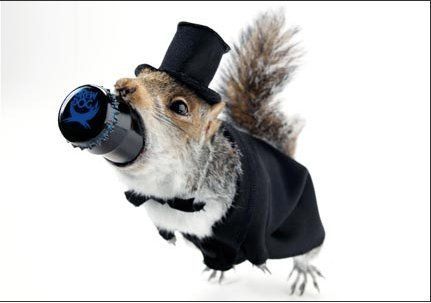
If you're wondering what The End of History will be like, here's a preview: There will be dead animals and beer. At least that's how James Watt of Fraserburg, Scotland, envisions it. As the co-founder of BrewDog, Watt is responsible for producing an ale with a higher alcohol content than whiskey and vodka -- 55 percent alcohol by volume -- which also happens to comes in bottles wrapped in taxidermic roadkill. Yes, really.
"Beer has been brewed for over 10,000 years, and this is the strongest beer the planet has ever seen," Watt boasts. "This beer is bold, irreverent and uncompromising. A beer with a soul and a purpose. A statement of intent. A modern-day rebellion for the craft-beer proletariat in our struggle to over throw the faceless bourgeoisie oppression of corporate, soulless beer."
Watt and his partner Martin Dickie began brewing at home when they couldn't find a beer they liked in the United Kingdom. In 2006, they met Michael Jackson (the noted Scotch connoisseur, not the King of Pop), who told them to quit their jobs and start a brewery. So they did, when they were both 24. But their mission is more to celebrate craft beer than to make a ton of money.
The blond Belgian ale is infused with juniper berries and nettles, and it's concentrated by repeatedly freezing the liquid and extracting the ice crystals. It is the beer to end all beers. The end of beer history. (Take that, Fukuyama!) So, to celebrate the achievement, Watt decided to dress up the beer. The twelve bottles that have been produced thus far were stuffed within seven stoats, four squirrels and one hare. Yes, you read that right.
"The impact of The End of History is a perfect conceptual marriage between taxidermy, art and craft brewing," Watt says. And like most marriages, it's not cheap. One bottle of The End of History ale will set you back 500 pounds ($750). And this beer is not to be chugged while watching a footie game, but rather poured into a shot glass and "enjoyed like a fine whiskey."
Taxidermist Tony Armitstead sourced and stuffed all 12 animals from local roadkill (these animals died of natural causes before being stuffed, and you can rest assured that there's no smell!). The preserved animals are then dressed up in custom-made outfits, like tuxedos and kilts, by a local seamstress. This intricate taxidermy "costs loads," and it's the science of stuffing that determines the high price point.
"The bottles are at once beautiful and disturbing -- they disrupt conventions and break taboos, just like the beer they hold within them," Watt says. And it's not the first time BrewDog has broken convention -- their Tactical Nuclear Penguin brew was previously the world's most alcoholic beer, with 32 percent alcohol by volume. (By comparison, Budweiser is 5 percent alcohol by volume.)
"We want to put the enthusiasm, passion, craft and integrity back into beer drinkers' glasses," Watt says, although he has a feeling most of the bottles won't actually make it into the glasses. He muses that they're more likely to end up on a mantle as part of an art collection than down the hatch like most brewskies.
Response to BrewDog's irreverent and perhaps confusing marriage of beer, art and taxidermy has raised a few eyebrows. While some fans appreciate the "devil-may-care attitude" and the imagination and innovation, others find it "disturbing" and have taken issue with animal cruelty. But that's OK, because Watt is not actually trying to sell many cases of beer. He's simply trying to get people talking about craft beer and instill in them the passion he himself has developed.
"We could have easily sold 1000 stoats," but this was not a "commercial exercise," Watt says.. BrewDog's The End of History is intended to make a statement, and BrewDog's founders say their new line has provoked a massive amount of debate and discussion.
"We want to have fun and unsettle a few stuffy old institutions and rattle a few cages whilst we are doing it," he says. We'll drink to that!
The original version of this article appeared on AOL Small Business on 8/5/10.